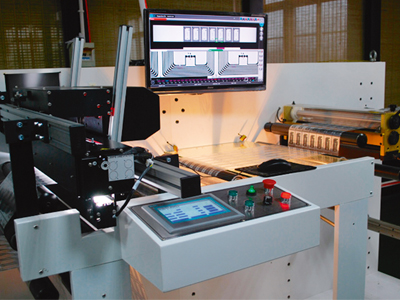The Helios II system from AVT
Inspection of the web is nothing new, but with increased demands for accurate colour control, higher print quality and less waste from print defects, print inspection system and associated processes are becoming essential to flexographic printing. By Neel Madsen.
Historically web inspection was done with cameras that scanned parts of the web or through a simple line scan operation, but as print faults and waste has become less and less acceptable, these systems are no longer enough to eliminate waste and reduce press downtime. Brands want the print they signed off on 100% of the time to protect the brand identity and standout shelf appeal. Equally printers can’t afford to throw away faulty flexible packaging or labels in any significant amount.
For complete assurance, a 100% web inspection system that inspects 100% of the web 100% of the time will detect process and random faults as well as colour variation, mis-register, and mis-prints and alert operators so that remedial action can be taken.
‘Profitability comes, in part, from repeatedly delivering quality products to customers on time, and this can be achieved by systematically controlling every stage of production and eliminating bottlenecks. Maximising press and other equipment usage is also a key factor to profitability,’ said Stephan Doppelhammer, market manager for packaging, at QuadTech.
Achieving colour targets quickly and accurately with an inline colour management system using L*a*b* and Delta E values will ensure that consistent colour is run for each colour, on every press and even in different locations. The job information and colour targets can also be stored for use on repeat jobs.
‘Closed-loop solutions that are capable of registering varnishes, lacquers and cold-seal adhesives and front-to-back registration as well as colours can prevent expensive waste. The QuadTech Autotron with ClearLogic provides such assurance and can maximise output,’ said Mr Doppelhammer.
He went on to say that even once the job is up and running in perfect register, there are still a host of process faults that can arise. A web viewer will provide real time viewing of the moving web and for this QuadTech has the Web Viewing System.
If using a QuadTech Inspection System, defect information is automatically sent to QuadTech’s optional Data Central reporting tool for analysis by quality control personnel – who can decide whether part of the print needs to be removed. That information is then sent to the rewinder. The system controls the rewinder, running it at optimum speeds between areas where defective print needs to be removed.
Mr Doppelhammer concluded, ‘Solutions like these, available from QuadTech for inline and CI flexo presses, address the major factors that impact margins and profitability; the immediate results of such systems also mean that there can be a rapid return on investment.’

Stephan Doppelhammer, market manager for packaging, at QuadTech
Advanced vision
AVT’s Helios is a line of automatic 100% print inspection solutions designed for labels and narrow web printing. The product range includes Helios II, dedicated to supporting every stage of the production process, and Helios S, which supports an extensive range of printed materials.
Helios II can be integrated into rewinder/finishing equipment to create a designated Automatic Inspection Station for post-print processes. It deploys advanced algorithms designed to detect any type of defect, and features built-in archiving and reporting, including a built-in PrintFlow module. An efficient in-line monitoring tool reports total good material printed, and the solutions works seamlessly on any substrate and any application.
In South Africa, Rotolabel recently installed a Helios S system from AVT (sold through its SA agent Rotocon). This recently developed solution handles all substrates, even thick embossed metallised substrates as well as highly-reflective holographic foils and laminates.
Acquired by the Bidvest Group in 2008, Rotolabel today represents the Labelling Solutions division of Bidvest Paperplus – a leading supplier of printing, communications, packaging, labelling and stationery solutions in southern Africa. It specialises in flexographic, letterpress and digital print technologies, allowing the ability to print labels of consistent high quality on a range of substrates with a variety of finishes. Wicus Maritz, managing director of Rotolabel, commented, ‘With the purchase of other equipment through Rotocon, they have proven to be a reliable partner. We look forward to integrating the AVT Helios S inspection system into our production workflow.’
AVT’s solutions offer 100% quality assurance capabilities throughout the entire print production workflow, from set up through printing to finishing, inspecting any application and any substrate or print type. This also applies for its range of inspection systems for packaging print. The flagship Argus Turbo system offers 100% inspection of the web 100% of the time, while in parallel employing an area-based camera that can zoom in on various sites of particular interest. The system will indicate the position and type of defect, enabling operators to quickly address problem areas and correct the relevant defect source. Both repeating and random defects are automatically marked according to selected quality thresholds, and if necessary, the high-resolution matrix camera is pointed to the suspected defect location for further investigation of the problem. A report issued at the end of roll indicates the defects’ location, including images of the defect and its corresponding master.
Now also for labels
Established in 1969, Italian manufacturer Grafikontrol has installed on numerous systems in the wide web sector for both gravure and flexo printing around the world. Its latest system, Lynex, inspects 100% of the web, displaying a real-time, high resolution, full width image of every print repeat to the operator, and provides production analysis and data collection.

Grafikontrol’s Lynex inspection system
The system, which is being shown at Labelexpo, is composed of one or more linear colour cameras. These can operate at production speeds of up to 900 m/min while maintaining perfect image resolution. Lynex is suitable for inspection on any type of printing presses. It incorporates white LED lighting to ensure quality and light distribution without image degradation, even on metallised or other difficult surfaces.
‘We want to make our products known within the label market, where control systems are already a must,’ said Paolo De Grandis, sales director. ‘The label sector is relatively new for us. Labels are the natural extension of the success that Grafikontrol has achieved in the large format package printing market. Since we started working with narrow web press manufacturers, Grafikontrol has already installed multiple systems at label printers in Europe.’
Keeping it clean
In flexibles packaging printing, the issue of web cleaning also arises. Dust and other contaminants on the web can lead to print defects and increase press downtime. Meech has a range of web cleaning products which include features that offer cost and energy savings.
CyClean is a compact, non-contact, double-sided blow and vacuum-based web cleaning system, which flows contaminants into an inline filter unit. It cleans webs up to 2.5 metres in width, is capable of removing 0.5 micron contaminants and has a small footprint that enables it to be fitted into confined spaces. Integrated static control on the entry and exit of the cleaning head guarantees a thorough, long-lasting cleaning process. The AC ionising bars neutralise all static charges on the web and ensure easy breakdown of the bonds holding contaminants to it. The risk of re-attracting contaminants to the cleaned web surfaces is also significantly reduced.
Providing excellent cleaning power and removing particles as small as 0.5 microns, Meech’s TakClean offers continuous single or double sided cleaning capabilities, it is available for web widths up to 2.1 m, at a speed of up to 250 m/min. When cleaning, elastomer rollers make contact with the web, lifting contamination from the product surface. Meech’s VacClean contact cleaning system will remove particles of less than 2 micron from double-sided webs up to 4 metres wide. A non-contact system, ShearClean is available for web widths up to 2.1 metres and for web speeds up to 600 m/min, although faster speeds can be achieved by adjusting factory settings. As with all Meech web cleaners, ShearClean incorporates static control technology to aid removal of contamination.
Adam Battrick, sales director at Meech International, said, ‘Web cleaning systems need to achieve two main actions for successful cleaning: the boundary layer of air on the web must be broken, allowing contamination trapped under and within it to be removed, and the static charge on the web must be eliminated so that contamination can be isolated. Only a system capable of achieving both these actions will result in a spotless web.’






